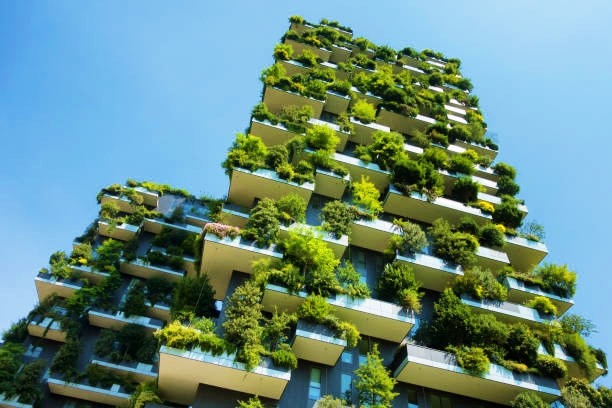Sustainable architecture is a relatively new concept that the modern world is embracing. It involves the use of environmentally friendly building materials, efficient energy management and the reuse of existing materials to reduce the environmental footprint of construction projects. This article will discuss the definition of sustainable building, its benefits, challenges, and examples of how the concept can be used in the modern world. It will also look at the future of sustainable building and the potential benefits it can bring.
What is Sustainable Building?
Sustainable construction is an important concept in the modern construction industry. It is the practice of constructing buildings and structures in an environmentally responsible manner. This includes the use of renewable and resource-efficient materials and energy, reducing the building’s environmental impact and providing a healthier environment for occupants.
Additionally, sustainable construction includes the use of green technologies and building practices to reduce a structure’s overall energy consumption, among other measures such as the use of recycled materials and the introduction of natural light. Sustainable construction is becoming increasingly popular because it offers many benefits, from lower energy costs to improved building aesthetics.
The Benefits of Sustainable Building
Sustainable construction is an environmentally responsible way of building and maintaining infrastructure. It involves using environmentally friendly materials and methods, conserving natural resources and reducing the environmental impact of construction. Sustainable buildings have several benefits, including reduced energy consumption, reduced air and water pollution, improved quality of life, and economic savings.
Sustainable buildings help reduce energy costs and protect the environment by harnessing renewable energy, utilizing recycled and sustainable building materials, and utilizing energy-efficient building practices. Additionally, by promoting green technologies, sustainable buildings help create jobs in a green economy and help reduce costs associated with traditional construction methods. Sustainable buildings are an important part of the global effort to reduce our carbon footprint and create a more sustainable future.
Sustainable Construction Challenges
Sustainable construction is the practice of constructing buildings and infrastructure in a cost-effective and environmentally responsible manner. This type of architecture has grown in popularity amid growing awareness of the effects of climate change and other environmental issues. However, many challenges must be faced to achieve a successful sustainable construction project. One of the biggest challenges is finding materials and methods that are cost-effective and environmentally friendly.
Additionally, sustainable construction projects often require a unique set of skills and expertise that may be difficult to find in traditional construction firms. Finally, many sustainable construction projects require large initial investments that may be difficult to secure. Despite the challenges, sustainable construction is becoming an increasingly popular option for many construction projects.
examples of sustainable buildings
Sustainable architecture is an increasingly important topic in modern times as more and more people focus on reducing the environmental impact of their activities. Sustainable construction involves the use of materials and technologies to reduce the carbon footprint associated with a building’s construction, use and eventual demolition. Examples of sustainable building techniques and materials include the use of renewable energy sources such as solar and wind power, recycled materials, environmentally friendly insulation and water harvesting techniques.
Construction companies are now taking a more proactive approach to sustainability, and the results are already evident. In the future, sustainable architecture will continue to play an important role in ensuring our environment remains as pristine as possible.
The future of sustainable construction
The future of sustainable construction is bright and full of potential. Sustainable construction is the practice of constructing and maintaining structures and infrastructure in an environmentally responsible and resource-efficient manner. This approach helps reduce the impact of the built environment on human health and the natural environment, while reducing costs and increasing efficiency. As awareness of sustainable building grows, the industry is responding with increasingly accessible and innovative green building technologies and processes. By adopting sustainable building practices, we can ensure a safer, prosperous and sustainable future for future generations.
The Benefits of Sustainable Building
Sustainable construction is a term used to describe the process of constructing buildings that are designed and constructed to minimize their impact on the environment. Sustainable building practices are gaining popularity among architects and builders due to their many benefits. These benefits include cost savings, increased building durability, improved energy efficiency, improved indoor air quality, reduced waste generation, and improved resource utilization.
Sustainable construction also helps protect the environment by reducing the amount of materials needed for construction, reducing air and water pollution, and conserving natural resources. Additionally, sustainable architecture can improve the health and comfort of occupants by using natural materials such as stone and incorporating natural light and ventilation. Ultimately, sustainable building practices contribute to healthier, more efficient, and more durable buildings that better protect the environment and users.
In conclusion, sustainable architecture has evolved from a concept to a reality in the modern world. Sustainable construction brings many benefits, such as cost savings, environmental protection, and improved worker health and safety. However, there are also some challenges, such as the high initial cost of building sustainable buildings. Still, with examples of sustainable building projects popping up around the world, the future of sustainable architecture is clearly looking bright. By investing in sustainable construction projects, we can have a positive impact on the environment and help ensure a better future for future generations.

